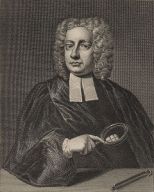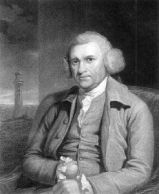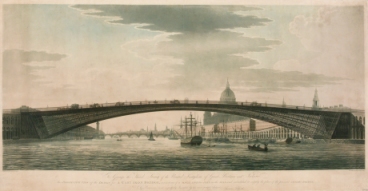 John Smeaton’s experiment to estimate the efficiency of waterwheels. Philosophical Transactions 51 (1759).
John Smeaton’s experiment to estimate the efficiency of waterwheels. Philosophical Transactions 51 (1759).
This post continues our examination of Simon Schaffer’s “Machine Philosophy: Demonstration Devices in Georgian Mechanics” (1994). Last time, we looked at how Atwood’s Machine was used at Cambridge as a dramatic means of convincing mathematics students of the validity of Newton’s laws, which they were expected to use to explain various physical phenomena. Here we examine how proponents of Isaac Newton’s mechanics tried to use the machine to make points with audiences whose perceptions of the reach and fundamentality of Newton’s laws were varied and unstable.
First, though, let’s revisit some of the themes of Schaffer’s earlier works to see how this piece fits into a larger picture.
1) Schaffer has a very longstanding concern with historical actors’ rhetorical efforts to construct a clearly progressive “Newtonian” tradition founded upon, and latent in, Newton’s works, and to cast themselves as the rightful inheritors of it. According to Schaffer, in certain milieus, notably Hanoverian Britain and Enlightenment France, this proved such a powerful strategy that subsequent historians became likewise occupied with reconstructing the historical development of a “Newtonian” philosophy in the 18th century and beyond. This historiographical legacy, he has argued, poses severe hermeneutical problems for historians.
2) Schaffer has also repeatedly highlighted the importance of debates over the reach of Newtonian mechanics, with attendant implications for theology and moral philosophy. In particular, some forms of matter—notably fluid material (including “souls” and “spirits”) and fire (including the “electrical fire”)—and some forms of physical activity—notably chemical, physiological, fermentative, combustive, and intellectual activities—were widely believed to not abide by Newtonian principles. This non-mechanical physics played an important role in theological arguments. The soul was often supposed to be composed of, or to act through, pneumatological forms of matter. Electricity was widely suspected to be central to physiological operation, as well as a cause of, for example, earthquakes. Fire was considered an obvious medium for divine intervention. (Joseph Priestley’s 1777 work Disquisitions Relating to Matter and Spirit was considered theologically radical, and was widely denounced as atheist, for its denial that souls and God operated as part of, or directly upon, the material world.)
3) Accordingly, experimental demonstrations and philosophical lectures were often freighted with moral, and thus political, lessons. Electrical showmen could claim that their demonstrations directly showcased divine power, thus reinforcing clerical authority. Similarly, the law-driven regularity of the Newtonian cosmos could, according to Schaffer (such as in his 1982 film Science and the English Enlightenment), be cast as an ideal form to which society could aspire, thus likewise idealizing established political orders.* Moreover, the divine intervention apparently necessary to ensure the stability of the Newtonian cosmos reaffirmed the active and benevolent intervention of the deity. However, enlightened political philosophers could also hope to uncover similar sets of principles governing the functioning of societies and polities, even perhaps inaugurating a radical new political age.
 Desaguliers
Desaguliers
In “Machine Philosophy” Schaffer is only sporadically concerned with the uses of demonstration devices to teach moral lessons to genteel audiences. In this case he is more concerned with narrower intellectual debates. Where he discusses how the devices were used to diffuse “the esoteric truths of mathematical philosophy” among “innumerate and polite social milieus” (158), it is either as a means used by patronage-seeking engineers to convey “their mastery over nature’s powers” (159); or—in a move that will be familiar to today’s proponents of popularized science—it is a tool used to recruit new members of the philosophical ranks. In the first volume of his Course of Experimental Philosophy (1734), “engineer” and Newton acolyte John Desaguliers (1683-1744) wrote that “a great many Persons get a considerable Knowledge of Natural Philosophy by Way of Amusement; and some are so well pleas’d with what they learn that Way, as to be induc’d to study Mathematicks, by which they at last become eminent Philosophers” (159).
However, between different eminent philosophical circles, precisely what an experimental demonstration might and might not accomplish was a matter of dispute.
Famously, throughout the 18th-century supporters of Newtonian principles clashed with those who, following Gottfried Leibniz (1646-1716), supposed matter was endowed with a vis viva, or “living force”. Vis viva was a quantity understood to be conserved and imparted from one body to another. Physically and mathematically it is recognized as a predecessor to the energy concept. (Its quantity was reckoned as proportional to the square of a body’s velocity.) But it also had cosmological significance, implying that matter could be self-propelled, and also that all activity in nature could be attributed to the action of common matter.
Such “materialism” and its attendant embrace of conservation principles was philosophically repugnant to those whose theology required the external intervention of souls and the divine. Thus, upholding the fundamentality of Newton’s physical principles was also a way of asserting not only the passivity of matter, but also (counterintuitively to a 21st-century reader) the cosmological necessity of non-physical motivating forces and the attendant falsity of the vis viva conservation principle.
 ‘s Gravesande
‘s Gravesande
In practice, these debates could direct major attention to experiments viewed as peculiarly illustrative, such as that performed in the 1720s by Leiden natural philosopher Willem ‘s Gravesande (1688-1742), where the dimensions of indentations in potter’s clay and wax made by falling bodies could be shown to depend on the distance of fall in a way that accorded with the vis viva principle. But, where some might suppose the experiment quantitatively showcased the instantaneous transmission of vis viva, opponents such as London physician Henry Pemberton (1694-1771), followed by Desaguliers, could reinterpret the experiment in Newtonian terms by emphasizing the action of Newtonian forces over a short but crucial interval of time.
Later in the century, while George Atwood’s (1745-1807) machine could not settle the long-running dispute, its carefully balanced counterweights could be used to exhibit the action of retarding forces over clearly perceptible spans of time, but otherwise “[aping] the old-fashioned impact experiments… No messy and incalculable potter’s clay was required” (171). Thus, the “complex phenomena of impact on soft bodies were rendered intriguing oddities rather than doctrinally basic” (172). The critical importance of ‘s Gravesande’s experiment was neutralized, and the position of the self-appointed inheritors of “Newton’s legacy” (172) reinforced.
Similar issues surrounded the question of what constituted a sound engineering principle and what constituted a fundamental physical principle. On this score, Schaffer points to the rotational force experiments of “eminent engineer and instrument maker”—and vis viva proponent—John Smeaton (1724-1792).
 Smeaton’s rotational force experiment. Philosophical Transactions 66 (1776)
Smeaton’s rotational force experiment. Philosophical Transactions 66 (1776)
In 1759, Smeaton published the results of small-scale experiments, illustrated at the top of this post, where he used a weight to estimate, in a “confessedly provisional” (175) way, the practical impact of friction on the efficiency of waterwheels. These results were widely celebrated. In 1776, though, he published an experiment that he claimed minimized friction where a weight rotates a spindle attached to two lead cylinders. According to Smeaton, the results of this experiment showed, in accord with Leibnizian vis viva, “that the mechanic power [of the weight’s fall] was proportional to the square of the cylinders’ speed [and] that the product of the weight and its time of fall was proportional to their speed…” (Schaffer) This, furthermore, was not a mere engineering principle, but a “universal law of nature respecting the capacities of bodies in motion to produce mechanical effects” (Smeaton, quoted in Schaffer, 176).
 Smeaton
Smeaton
The question of the presence of friction was critical to Cambridge mathematical philosophers’ defense of the fundamentality of Newtonian principles in the face of such experimental claims.
As we saw in the last post, these principles constituted for the Cambridge authorities unquestionable presuppositions rather than speculations to be proven. It was, therefore, their task to interpret results in terms of these principles. For them, friction constituted “an all-embracing resource” (173), which was constantly used to explain divergences between experiments and theoretical predictions. Accordingly, they claimed that, factoring in friction, Smeaton’s experiment could easily be reconciled with Newtonian philosophy.
Schaffer speculates that there “is at least a chronological reason to suggest that Atwood’s development of his own machine between 1776 and 1779 was in immediate response to Smeaton’s techniques” (174). This is an intriguing suggestion given Atwood’s similar use of counterweights to equalize forces and to isolate different sources of force and resistance.
In any event, though, Schaffer points out that in 1784 Atwood unfavorably contrasted Smeaton’s later disregard for friction with the care with which it had been measured in Smeaton’s earlier tabletop waterwheel experiment. (Although Schaffer doesn’t really mention it, no doubt it also contrasted with the degree to which Atwood had minimized friction in his soon-to-be eponymous machine.) In making this contrast, Atwood cast himself as a superior arbiter of the crucial role friction did and did not play in relating experiment to philosophy.
 Thomas Malton’s painting of Thomas Telford’s proposal for a single-span London Bridge (1801). Click for a larger version at the Science Museum Group collections website.
Thomas Malton’s painting of Thomas Telford’s proposal for a single-span London Bridge (1801). Click for a larger version at the Science Museum Group collections website.
If Cambridge authorities could use friction to defend themselves from the judgment of engineers, they could also use it to assess proposed engineering projects. Schaffer cites how Atwood served with such eminent authorities as John Playfair (1748-1819), James Watt (1736-1819), and Nevil Maskelyne (1732-1811) on the committee evaluating engineer Thomas Telford’s (unsuccessful) proposal to replace the old London Bridge with a single-span iron bridge. Atwood argued that if a bridge was feasible in theoretical principle, friction would only enhance its practical stability.
Schaffer concludes “Machine Philosophy” with a brief analysis of instrument makers’ marketing of Atwood’s machine. I will forgo discussion of that subject, except to note their avoidance of philosophical controversies in favor of playing up the machine’s precision design and the fine-tuned skill necessary to use it.
In Pt. 3, we shift to a different facet of “machine philosophy” with a look at Schaffer’s treatment of the ideology of Charles Babbage we turn to the place of perpetual motion machines in the intellectual life and political economy of the 18th century.
—
*This point is also made in an exhibit on Newton at the Cambridge Whipple Library’s website.